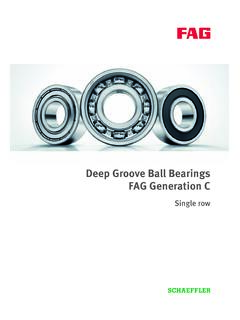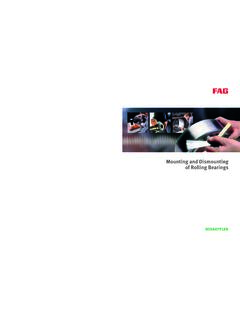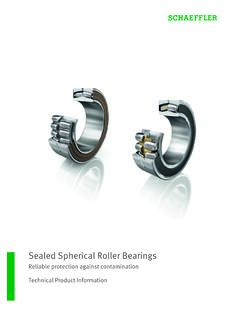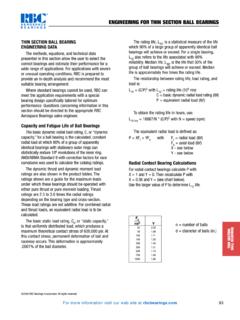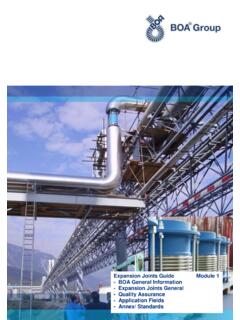Transcription of BEARING FAILURE: CAUSES AND CURES - Schaeffler Group
1 BEARING FAILURE: CAUSES AND CURES BARDEN PRECISION BEARINGS a BARDEN PRECISION BEARINGS Identitging and correcting CAUSES of BEARING faihue. Precision ball bearings are designed to have a long and useful Ii e. Assuming the application is correct to begin with, maximizing longevity means bearings must be properly installed, lubricated and maintained. Poor operating environments. oarticularlv moist or contaminated areas. ind improper handling practices invite premature BEARING failure. - When a BEARING does fail, it is important to determine the exact cause so apprcipriate adiusfments can be made. Examination of th6 failure mode ohn reveals the true cause of failure. ?his procedure is compli- cated by the fact that one failure mode may initiate another.
2 For example, corrosion in a ball race leaves rust-an abrasive-which can cause wear, resulting in loss of preload or an increase in radial clearance. ?he wear debris can, in a grease-lubricated BEARING , impede lubrication. resulting in lubrication failure and subsequent overheating. ?his guide will assist in properly identifying and analyzing 12 primary CAUSES of BEARING failure. Each characteristic is described in detail and is shown in diagram form, accompanied by a color photograph. Flaws, in most cases, are readily apparent. In some cases, the imperfections may be virtually invisible to the naked eye. Specific remedies for each situation are also suggested. Your Authorized Barden Representative will be happy to provide you with additional assistance upon request EXCES VERHEA?
3 FALSE LOAD isrnlnrstinl BRINE1 i'remahL~. u, area in ball path. rings, ball , Elliptic: marks s .. - . ~t each ;ition. ball por LLING lentations Nays. ball in< in racer Balls sh wear b; metal fron ~ntact surf? CONTAMINATION Denting of hearin CORROSION Chemical attack g r1 Is. Di racewavs and bal results in [b tri lue/brown) ball reddishlt icks and balls. discolors MISAI Racem 1 of rfaces. racewa scoloratiol ounting su Excessive loads usually cause EXCESSIVE premature fatigue. it fits, and improper preloading can also ring about early $time Eailure, (see Tit Fits, p. 15 and True &ine, p. 7). 'Ibis type of ~luoksthehesaraas~ fatigue. &+ bavy ball wear paths, evidence of overheating and a more wide@ spalling [fafigye area) are u& evident with shortened life.]]
4 ?he selution is to reduce the load crredegignusinge~ BEARING with grsatsr capacity. OVERHEATING Symptoms are discoloration of the rings, balls, and cages from BluelBlack gold to blue. Temperatures in excess of 400 F can anneal the ring and ball materials. The resulting loss in hardness reduces the BEARING capacity causing early failure. In extreme cases, balls and rings will deform. 'Ihe temperature rise can also degrade or destroy lubricant Common culprits are heavy electrical heat loads, inadequate heat ~aths. and insufficient coolinx or lubrication when loads and speeds are excessive. Thermal or overload controls, adequate heat paths, and supplemental cooling are effective CURES . Look for bluelblack and silv~rlgold dtscolomtion Balls FALSE BRINELLING -/ False brinelling-elliptical B& path wear marks in an axial direction at each ball position with a bright finish and sharp demarcation, often surrounded by a ring of brown dehris-indicates excessive external vibration.
5 A small relative motion between balls and raceway occurs in non-rotating ball bearings that are subject to external vibration. When the BEARING isn't turning, an oil film cannot be formed to prevent ~rina~ ~mks raceway wear. Wear debris oxidizes and accelerates the wear process. Correct by isolating bearings from external vibration, and using greases containing antiwear addiGes such as molybdenum disulfide when bearines onlv Gillate or reverse rapidly & in aduator motors. False brineU aka TRUE BRINELLING Bd Path / \ ball Spacad Brinelling occurs when loads exceed the elastic limit of the ring material. BrineU marks show as indentations in the raceways which increase BEARING vibration (noise]. Severe brinell marks can cause premature fatigue failure.)
6 Any static overload or severe impact can cause brinelling. Examples include: using hammers to remove or install bearings, dropping or striking assembled equipment, and a BEARING onto a shaft by applying force to the outer ring. Install bearings by applying force only to the ring being press- fitted, , do not push the outer ring to force the inner ring onto a shaft. Careful handline A NORMAL FrnGUE FAILURE Spalled Area Moderately spalled area indicates Fatigue failure-usually referred to as spalling-is the fracture of the running surfaces and subsequent removal of small. discrete particles of material. Spalling can occur on the inner ring, outer ring, or balls. This type of failure is progressive and once initiated will spread as a result of further operation.
7 It will always be accompanied by a marked increase in vibration, indicating an abnormality. The remedy is to replace the BEARING or consider redesigning to use a BEARING having a greater calculated fatigue life. reached the limits of its useful Me. REVERSE LQADING are designed to accept an -1 oad in one directionbnly. When loaded in the opposite direction, the elliptical contad area on the outer ring is truncated by fhe low shoulder on that side of the outer ring. The msutt is excessive stress and an increase in temperature, followed by increased vibration and earlv failure. Failure nuode is very s&ir to that of heavy in%hnce (tight) %.?he balls will showapoved wear band d by the ball Mng overtheautdgeclgeafthe~y.
8 Corrective action is to simply install the BEARING wd. wntactbeadqs mustbe withtheresultant~onthewide face-wbich is marked %stn-of the outer ring and the opposite face of the inner ring. Conhmhxdion is one of the leadinn CAUSES of be- failure. hmguh dents or material embedded Bds will be aid& dented, dull, or scratched. - Contamhation symptoms are denting of the BEARING raeeweys and balls resulting in high vibration and wear. Contaminants include airborne dust, dirt or any abrasive sub- stance that finds its way into the BEARING . Principal sources are dirty tools, contaminated work areas, dii hands and fomign matter in lubricants or cleaning solutions. Clean work areas, tools, fixtures and hands help reduce contam- ination failures.
9 Keep grinding operations away from BEARING assembly areas and keep bearings in their original packaging until you are ready to install them. Seals are critical-damaged or inoperative seals cannot ~roted bearinns Discolored (bluelbrown) ball LUBRICANT trah and balls are swptoms FAILURE of lubricant failure. Eiceisive wear I of balls, ring. and cages will follow, resultina in overheatinn and Balls wfll also be bluehkk subseqGent catastrophLc failure. ball bearings depend on the continuous presence-of a very thin -millionths of an inch-film of lubricant between balls and races, and between the cage, BEARING rings, I ! and balls. Failures are typically i caused by restricted lubricant flow or excessive temperatures that degrade the lubricant's properties.
10 Barden engineers can advise i users on the most suitable lubricant 9 e and quantity to use. Refer to lu ricant section of Barden C-10 dog for more information. Also, i any steps taken to correct improper 1 fit control preload better, and cool I the shafts and housings will reduce BEARING temperatures and improve lubricant life. CORROSION ball path I \ or deposits on dngs. Redlbrown areas on balls, race- ways, cages, or bands of ball bearings are symptoms of corrosion. This condition results fmm exposing @ bearings to corrosive fluids or a cor- rosive atmosphere. The usual result is increased vibration followed by wear, with subsequent increase in radial clearance or loss of preload. In extreme cases.

